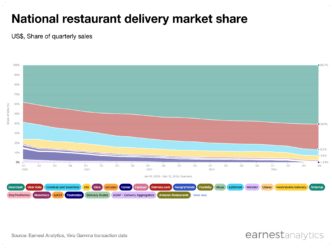Ask the Experts: Competitive Benchmarking Powered by CLV Ultra, Applied to Temu
In this episode of Earnest Talks, Michael Maloof, Head of Marketing at Earnest Analytics, sat down with Daniel McCarthy and Peter Fader (co-founders @ Theta) to unpack the methodology behind their new model, CLV Ultra, and apply it to Temu, Walmart, Etsy, Ebay, and other key competitors.
Peter Fader on the genesis and scalability of Theta’s CLV Ultra model: “What we’ve recently launched is kind of just the best of all worlds, as close as you can get to a free lunch. The idea of having our core “buy till you die” models tell in the same story how customers are operating. So if you think about the things that I mentioned before—seasonality, COVID, competition—there’s a lot of stuff going on, some which we can identify and put into the model, others of which we might not know what’s causing them. But it’s just as important to capture them. So this is basically leading edge machine learning meets these probabilistic, generative models of these “buy till you die” cohorts..And because of the ML piece of it, it’s really automated. We don’t have to spend a lot of time thinking about which variables to bring in. Makes it very scalable as well.”
Dan McCarthy on cohorting with CLV Ultra and Earnest’s benchmarking data: “What we care about most is actually, how well can we predict for customers where we have no data? And I think that’s where this ability to predict for the youngest of cohorts becomes especially salient. We can also then use the same model for very different companies, young ones, older ones. And we’ll have the same general framework that we’ll apply each time, and that enables us to be in this unique position where we can do these benchmark comparisons, especially because the underlying data that we’re using is also very comparable across these companies. The Earnest data is very nice in that every single company has data in the same structure. It’s all coming from the same credit card panel.”
Dan McCarthy on Temu’s post acquisition value (PAV) and its implications: “The high level conclusion with Temu is that the valuation of the customers is good…The absolute level of PAV is quite high…what [the chart] is showing is that there’s this very large spread in the PAVs across the customers. So about 30% of the customers have very low PAVs. They probably bought, you know, a sticker one time, and that was it. And so we’re inferring there’s not a whole lot of value to to those customers. But on the right hand side we see that there’s about 5% of the cohort that is worth over $3,000 per customer. This is in some sense the lifeblood of customer centricity, because it means that there’s great opportunity potentially to identify all the needs and the acquisition channels that are bringing in and creating value for these really good customers that could be potentially deemphasized for less valuable customers.”
Dan McCarthy on Temu customers’ repeat order behavior: “Further peeling back the onion, the way that we get the revenue is by first projecting out how many customers are live? And then, how many orders do they place? And that gives us the number of customers that are active in different periods…We see that at Temu when they make their first purchase, they’re spending somewhere on the order of 40 bucks and on the repeat purchases they tend to spend a bit more. These differences aren’t very big; it could be promotional discounts, or it could be that they’re kind of dipping their toe in the water before being comfortable making larger purchases. But in general customers tend to spend more when they make their subsequent purchases, and both of these figures seem to be trending in the upward direction, which is again a healthy sign for revenue.”
Daniel McCarthy on how Temu PAVs stack up against competitors: “So here we’re looking at eBay, Etsy, Temu, and Walmart. And you can see in general that the Temu figures are looking quite good again. They’re right up there with Walmart. I think the most important thing here are the PAVs. And again, the big conclusion here is that Etsy has relatively low PAVs. We can see eBay had relatively high PAVs but they’ve really come down. Walmart has generally had very high PAVs. They came down a bit, but they’ve stabilized and seemed to be moving up again. And Temu thus far has had high PAVs. So that’s a good sign for Temu again. All these figures are in terms of revenue…But certainly, you know, we don’t know the the gross margin profile of Temu, and that would be something that you’d want to be mindful of if you were looking at Temu as a potential investment.”
Peter Fader on applying the model across companies and categories: “That’s one of the great things about both—the consistency of the data from Earnest as well as the consistency of this modeling approach. Whether we’re talking about Etsy, Ebay, Temu, or if we’re talking about, you know, LVMH and so on. It’s people making discretionary purchases. Sure, the numbers on the Y axis would be a little bit bigger, but the basic patterns would be shockingly identical. And so you can still make apples to apples comparisons across companies in a seemingly very different part of the market. And that’s really nice to be able to make consistent comparisons across close companies, and even seemingly unrelated ones.”











